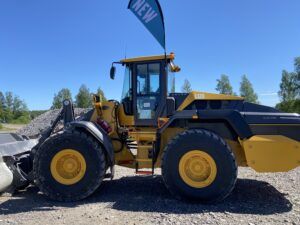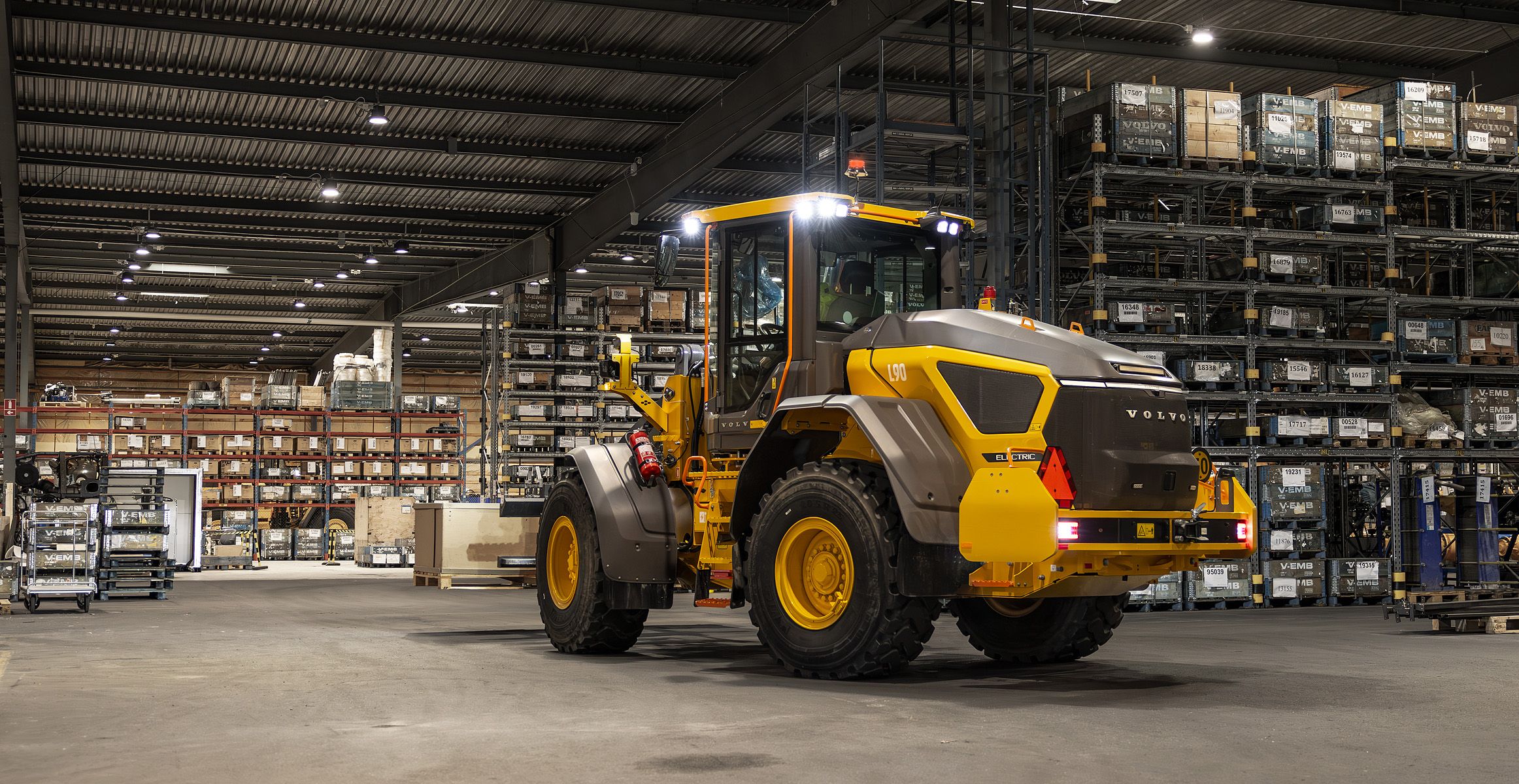iVT takes a visit to Volvo CE’s headquarters and proving floor in Ekilstuna, Sweden to stand up near its newly introduced mid-size electrical machines, with perception from the specialists.
With a spread of compact battery electrical machines now firmly established, Volvo Development Tools (Volvo CE) has begun the subsequent chapter in its electrification journey, with the announcement of two midsized wheel loaders, the L90 Electrical and L120 Electrical, alongside a brand new wheeled battery electrical excavator and an electrical, cable- linked materials handler.
The primary of those automobiles to be made out there to market – from the fourth quarter of 2024 – would be the 20-tonne L120 Electrical, which has a six-tonne lifting capability. The L120’s smaller stablemate, the 15-tonne L90 Electrical, mentioned to be the primary battery electrical wheel loader in its class, will comply with in chosen European markets in 2025.

The design of the brand new electrical wheel loaders has benefited from battery expertise developed elsewhere within the Volvo Group. “It’s a Volvo electrification system,” says Fredrik Tjernström, Volvo CE electromobility options knowledgeable. “It’s executed with the identical elements as you discover in battery electrical Volvo Vans.”
By way of battery manufacturing, Volvo CE is taking a strategic strategy to make sure high quality and management over their electrical machines. “There was an evolution,” says Tjerström. “Within the first compact machines we purchased batteries as full methods. However what you see within the new wheel loaders is the subsequent degree – we purchase the modules, after which assemble the batteries in our personal factories.”
This transfer in the direction of in-house battery meeting provides Volvo higher management over the standard and efficiency of their electrical machines. It additionally positions the corporate for future developments, with plans to ultimately produce battery cells in-house.
“Now we have began to construct our battery cell manufacturing facility in Skövde, in between Gothenburg and Stockholm [close to Volvo Group’s main powertrain plant]. So that’s the subsequent step for us,” says Tjernström.
When the battery plant was introduced in 2022 Martin Lundstedt, president and CEO of the Volvo Group mentioned, “Our ambition is that no less than 35% of the merchandise we promote shall be electrical. This ramp-up would require giant volumes of high-performing batteries, produced utilizing fossil free power and it’s a logical subsequent step for us to incorporate battery manufacturing in our future industrial footprint.”
“It’s a logical subsequent step for us to incorporate battery manufacturing in our future industrial footprint”
Electrical transmission
Some of the vital improvements within the new wheel loaders is the devoted electrical transmission. “We’ve eliminated the converter, which prompted a number of power losses in a traditional wheel loader, and electrical motors are instantly linked to the transmission,” says Tjernström. This not solely dramatically improves power effectivity but in addition enhances machine responsiveness and the general efficiency.
The L90 and L120 Electrical function separate electrical motors for hydraulics and propulsion, additional optimising power use and efficiency. “In a traditional wheel loader, you typically drive or function utilizing one foot on the brake and one on the fuel pedal,” says Tjernström. “As a result of if you need full hydraulic strain to lift the bucket rapidly, you step on the brake and push the throttle to construct hydraulic strain. However within the new electrical wheel loaders there isn’t any relation like that. So you’ll be able to pull the lever hydraulic lever, and you’re going to get full hydraulic energy immediately. The accelerator pedal solely controls the drivetrain.”
This decoupled system offers operators with instantaneous hydraulic energy and extra exact management over the machine’s actions. Whereas the brand new management paradigm might require some adaptation for knowledgeable operators accustomed to conventional machines, it finally ends in faster response occasions, improved power effectivity, and elevated productiveness by shorter cycle occasions, in addition to a extra intuitive studying curve for brand spanking new operators.

Matching diesel efficiency
A standard concern with electrical machines is whether or not they can match the efficiency of diesel counterparts. Volvo CE has addressed this head-on with the L90 and L120 Electrical. “You are able to do the identical work duties with this machine,” says Tjernström. “The distinction, in fact, is the runtime.”
Nonetheless, energy autonomy ranges are nonetheless spectacular with the L120 Electrical capable of work a full day of round 5 to 9 hours on a single cost, and the L90 Electrical lasting for roughly 4 to 5 hours of medium obligation operation. “The secret’s to plan your working day in such a approach that you just utilise non-productive time, utilizing breaks to cost the machine,” says Tjernström.
To make sure most run time Volvo CE has put appreciable thought and engineering into the battery expertise, which is temperature-controlled, that includes each cooling and heating methods to make sure optimum efficiency, whatever the local weather. “We’ve carried out in depth buyer exams in a number of websites in China, Dubai and Australia, with very constructive suggestions,” says Tjernström.
To boost the benefit of power provision, the charging methods for the wheel loaders have been designed with flexibility and practicality in thoughts. They’re suitable with current charging requirements, which reduces the boundaries to adoption for corporations seeking to combine electrical machines into their fleets.
“You cost it with a CCS2 inlet, in order that’s the identical charging requirements you have got for vehicles or vehicles,” says Tjernström, “So you’ll be able to share the charging infrastructure on website with different tools or automobiles.”
The L90 costs from 0-100% in about 70 minutes utilizing a 150kW DC quick charger or Volvo’s PU500 cell energy unit, whereas its AC on-board cable can energy up in six to seven hours for in a single day charging. The L120 costs from 10-100% in a single hour 40 minutes with a 180kW DC quick charger or the PU500 and in seven hours with a 40kW DC moveable charger. Each wheel loaders even have recuperative potential, utilizing braking power when decelerating to cost batteries, making certain an extended runtime and brake life.
Enhanced consolation and security
The advantages of the brand new electrical machines prolong past the discount in CO2 emissions. Tjernström factors out the numerous enhancements in operator consolation and website security: “They’ve a 3rd of the noise of an analogous diesel machines, but in addition a tenth of the vibrations. And that’s actually useful for operator consolation within the work surroundings.
“Operators typically don’t consider the affect of noise and vibrations till they struggle it. However then they expertise that they don’t seem to be as exhausted afterwards as they’re once they use diesel.”
The dramatic reductions in noise and vibrations additionally make the machines extra appropriate for city environments and enclosed areas, with the discount in emissions past simply carbon decreasing speedy damaging well being impacts of diesel machines. “The NOx, particulate matter and all the opposite emissions are eliminated,” says Tejernström, “In an city surroundings this reduces damaging impacts to the well being and well-being of the folks within the metropolis, in addition to the operators.”
Electrification has additionally allowed for extra superior management methods and oftware integration. Operators can simply entry features and settings from the intuitive interface, which integrates the Volvo Co-Pilot and rearview digital camera when fitted.
In the meantime, the machine’s powertrain, which was beforehand managed by mechanical methods, is now managed by software program. “Earlier than it was quite a bit in valves and hoses,” says Tejernström “However now it’s managed utilizing software program methods. This creates a brand new vary of prospects to remotely tune and customise the behaviour of the machine or the cooling system, or no matter.”
This software-centric strategy permits for higher customisation and ongoing enhancements by updates, extending the helpful life and capabilities of the machines.
With the L90 and L120 Electrical, Volvo CE isn’t just providing new machines; they’re offering a glimpse into the way forward for development tools – a future that’s cleaner, quieter, and extra environment friendly than it has ever been earlier than.
“It’s super-exciting,” says Volvo’s new director of expertise Mats Sköldberg. “These machines will discover purposes the place, from a complete value perspective, electrification can begin to make sense for purchasers. Now we’ve got the working hours, which imply the comparative value of gasoline within the diesel model will compensate their funding. We need to change bigger machines which emit extra CO2 and thereby enhance our affect.”
This text was first printed within the August concern of iVT Worldwide


